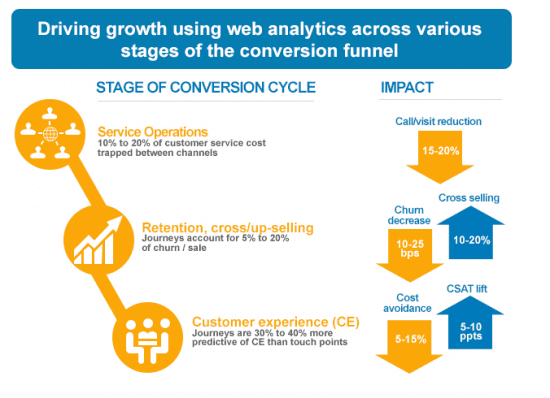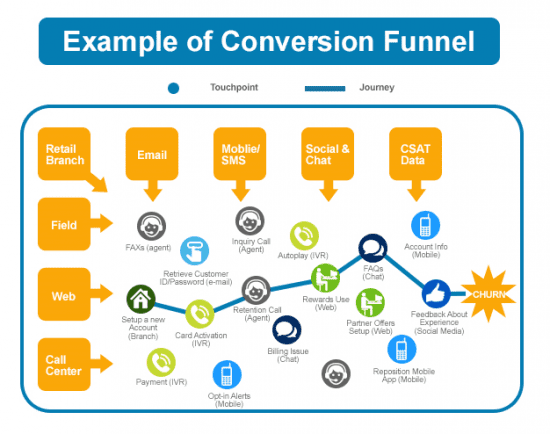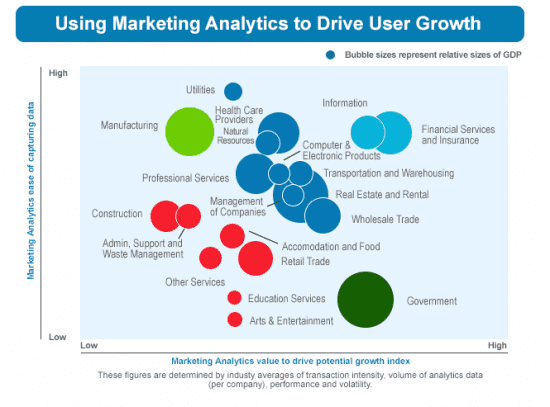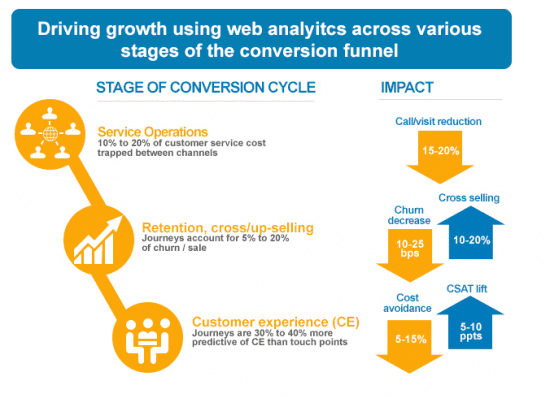Three ways to use marketing analytics to increase sales
As there are so many options available when using data analytics, why do some businesses typically rely on one single approach? The analytical tools available for the business leader's arsenal are now better and bigger than ever before, and are targeted to generate better decision-making. Despite this, and the ability of such tools to increase conversion rates, growth and MROI (marketing return on investment), some companies seem frozen by the choices on offer.

This causes business heads to default to their usual performance-management and planning approach, and the typical result is the discovery that even advanced single methodologies have limits. The variety of audiences and activities that marketing budgets support and the diverse time limits for investment requires an approach that's a little more complex. The ideal way for companies to improve their marketing effectiveness is to merge the various MROI options in such a way that allows the best attributes of each to shine through.
The improvements can be extremely impressive. A survey of our client revealed that our client engagements from the previous decade or so across different sectors and regions revealed that the integrated approach reduces marketing spending by between 15 and 20 percent. Globally, this means that around $200 billion could be freed by businesses to be invested elsewhere.
Take this example: A client of ours in the insurance industry in the US managed to increase its productivity in marketing by more than 15% every year from 2009 until 2012. The company succeeded in maintaining the same levels of marketing spending over this timeframe, compared to a rise in typical spending on marketing by similar businesses of over 60%. Marketing analytics allowed the company to improve the way it made important business decisions.
Using analytics to define strategy
The main strategy of any business defines its analytical choices. Without a firm base, companies simply allocate budgets for marketing based on last year's budget, or on which product or service performed the best in the last quarter or so. Such an approach leads to a political rather than analytical approach, where proposals that are 'flavor of the month' or sections that yell the loudest get the funding, rather than areas that need to develop the most.
It is far more appropriate to measure proposals on their economic worth or likelihood of return. Options that are scored using such numbers provide a streamlined and concise method for making comparisons, and such metrics can be combined with predetermined conditions such as baseline budgets, prior commitments and media thresholds.
Having an understanding of your customer's purchasing behaviour is the other prerequisite in creating a MROI portfolio that is effective. Consumer behaviour has altered so much in the last few years that old ideas of thinking about customers, such as the age-old marketing 'funnel', no longer apply.
The funnel dictated that brand awareness was the main driver behind increasing conversion rates and sales, but the emphasis is now upon the entire consumer decision journey. The purchasing process is much more dynamic than previously heralded, and consumer behaviour is influenced in several different ways.
For another example, one company who sold home appliances spent a large share of its marketing dollars on newspaper, magazine, TV and display adverts, aiming to create as much brand awareness as it could among its target customers.
Once the company performed the usual analysis, it discovered that most people searching for home appliances did so by browsing sites, and that less than 10% of customers visited the company's own web-site. As a result, the business began to invest in website content rather than traditional advertising, and as a result gained a 20% increase in e-commerce sales.

Better decision-making
The science of marketing analysis has improved thanks to new and better data sources, but non-scientific considerations remain important as well. Business know-how is required to challenge or ratify some approaches, but a creative approach is key in order to develop fresh ideas of how data can be used, or how new opportunities can be identified to unlock data. Such 'soft' skills are extremely useful when data quality and availability is uncertain.
For example, it's easy to use data to calculate how many people are responding to an email campaign, but in other areas it's not so easy to define. Such challenges, however, should not restrict the use of analysis to enable better decision-making.
Using data to make the best decisions is a three-step process:
1. Find the analytical approach that works best
Companies need to work out the pros and cons of all the appropriate analytical tools in order gain the most effective marketing mix. The prevailing choices when it comes to non-direct marketing include:
Reach, Cost and Quality (RCQ)
Reach, Cost, Quality (RCQ) and other Heurisitcs. RCQ reduces each touch-point into its component parts by using structured judgement and data. Such parts include quality of engagement, number of target customers reached, and cost per unique touch-point.
RCQ can be used when advanced analytical tools would not be of use, such as when data is limited, when spending is routinely consistent all year round, or in 'always-on' media where marginal investment effects are harder to extract.
RCQ allows all the various touch-points to be brought back to the same scale so comparison is much easier. It is simple to execute, but in practice refining the value of each specific touch-point presents challenges given the difference between the channels. RCQ also does not have the ability to account for interaction or network effects, and relies heavily upon the assumptions that drive it.
Marketing mix modeling (MMM)
Marketing-mix modeling (MMM) and other advanced analytical tools.MMM involves the use of big data to work out the effectiveness of spending per channel.
This involves statistically linking marketing investments to other sales-drivers, and usually includes external variables such as seasonal factors, competitor activities and promotional campaigns to reveal both interactive (for example, online and social media activities) and longitudinal (changes over time in segments and individuals) effects.
MMM is useful for both near-term and long-range planning, but it does have its limits. High-quality data is essential, particular with historical marketing spending and sales data, and it cannot measure activities with small amounts of variance, such as outdoor media. It also cannot be used to measure the long-term effects in investing in any one, single touch-point, such as a social media feed or a new smartphone app.
MMM also needs users who have expert econometric knowledge to understand the models, and a tool to plan scenarios to model the financial implications caused by making specific spending decisions.
Attribution Modelling
Attribution modelling and other emerging approaches. Attribution becomes increasingly important for marketing execution and online media purchasing the more money that is pumped into online advertising.
Attribution modeling is where a set of algorithms or rules govern how the credit for the conversion of traffic to sales is meted out to the various touch-points, such as online ads, social media feeds and email campaigns. This helps marketers to decide how useful each touch-point is for conversion success.
The most-used method, however, is to simply to assign full credit to the last action, which is usually the CTA button. Newer methods use regression techniques, advanced algorithms and statistical modeling to tie into real-time systems to generate a much more accurate overall picture. While such approaches are better than tying methods to rules, they still generally depend on using data from cookies as input, hence limiting the richness of the data and making it harder to accurately define the importance of each individual touch-point.
2. Generate insights by integrating capabilities
Some businesses still rely on using a single analysis technique, but better returns are the result of using MROI tools collaboratively. Such an approach, which includes using data and insights from direct responses, reduces the inherent bias in any single MROI method and allows business leaders to be flexible in moving budgets towards activities that produce the most worth.
How do such techniques work together?
A business may find that traditional advertising makes up around 80% of its marketing budget. Since such activities produce customer-measuring data that can be tracked longitudinally, it follows that MMM should be used.
Digital spending, however, can be more accurately tracked by using attribution modeling, and therefore highlighting the activities within broader categories that are most likely to generate the highest conversion rates. Moving forwards, the company could then make use of RCQ to monitor the other 20% of its marketing budget, which could go towards ways of reaching consumers who are hard to reach via the traditional advertising channels.
By developing frequent response curves across different analytical techniques, it helps marketers to place the value of each approach on an equal footing. They can then use a tool for decision-support in order to integrate the results, which will allow business leaders to track and share performance on a basis that's close to real-time, and make alterations quickly as needed.
For a further example, a large power company used RCQ to adjust its out-of-house and sponsorship mix. In doing so it increased reach and raised the efficiency of its marketing communications by over 10 percent. The business then used MMM to obtain a more accurate MROI assessment concerning spending on traditional media against online channels.
The results: each €1 million invested online by the company generated 1,300 new customers, while the same spend on traditional media helped them retain around three and a half times that many consumers, of which around four in ten would have stayed loyal to the brand in the long term anyway.
Such insights helped the business to understand where to concentrate its messaging in keeping existing consumers and attracting new ones.
When it comes to purifying the mix, it is sometime tempting to spend on short-term investments that generate high levels of ROI. This is fed by the fact that a lot of data comes from customers who engage in short-term behaviour, such buying products on sale and or signing up for an email newsletter. Short-term behaviours account for around 15% of total sales, while the brand accounts for the other 85%.
Companies need to ensure their marketing mix models can account for marketing effectiveness over both the short and long term.
One leading produce brand almost fell foul of this short-term thinking. It launched a vigorous social media campaign – photo-sharing, contests, advertising and shared-shopping-list apps. It succeeded in delivering the same levels of revenue as had been generated by traditional advertising, but at a much lower cost.
The brand considered moving most of its budget away from TV and newspaper/magazine advertising and into social media, but when it crunched the numbers over the long-term, it found that the impact of social media fell by 50%. If the brand had gone along and moved into social media as MMM would have dictated, it would have resulted in a net loss of profit.

3. Make the analytical approach the center of all you do
Teams typically throw analysis over the wall or outsource it. When the numbers come back, they are often reluctant to make changes as they don't understand the findings, or they don't trust them.
Marketers need to work in tandem with data experts, digital analyzers and researchers in order to come up with hypotheses to fine tune the maths and alleviate this problem. Businesses also need to nurture individuals who can both work out what the analysis tells them, and who understand business.
A bank, for example, set up councils within the marketing department so that the analytic and creative teams had a place where they could work together. This helped creatives to understand how the figures could shape marketing programs, and the analysts to understand what the business was trying to achieve. Such a collaborative approach can half the duration of MROI campaigns.
Agility and reaction times are also crucial. The tactical media mix needs to be created by evaluating the lessons gleaned by the customer decision journey and the allocation of the marketing mix.
Results need to be compared with targets as soon as they are available, and the spending and marketing mix adjusted in accordance. Attribution modelling is especially useful with campaign changes that need to happen immediately, since budgets for digital channels can be modelled quickly and accurately. The best-performing companies often reallocate as much as four-fifths of their marketing budget for digital channels during a campaign.
Business leaders find themselves under increasing pressure to demonstrate ROI from a whole host of different marketing programs. Both the tools and the data is available to enable business leaders to make more-informed decisions. An integrated analytical approach is the best way of finding out the most useful insights and driving brand growth above the levels exhibited by competitors.


Thank you to David Rosenfeld for sharing his thoughts and opinions in this blog post. David is an Analyst at
Infinite Conversions, a digital agency focusing on improving website’s sales and revenues through conversion rate optimization. You can read his
company’s blog .







 Thank you to David Rosenfeld for sharing his thoughts and opinions in this blog post. David is an Analyst at
Thank you to David Rosenfeld for sharing his thoughts and opinions in this blog post. David is an Analyst at 


